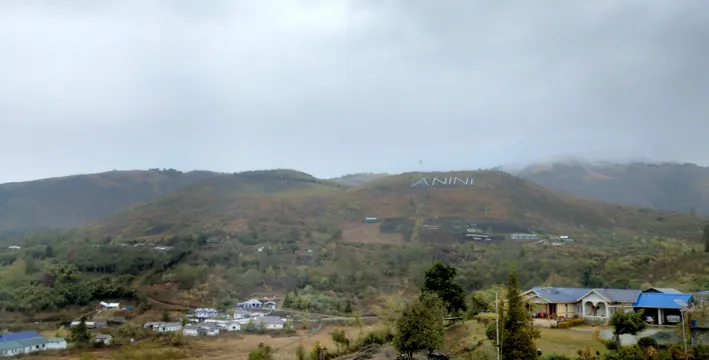Journey towards Anini, headquarters of the Dibang Valley district of Arunachal Pradesh is long and treacherous with road hugging mountains that drop thousands of feet down into the valley.
Anini is a town with hardly 4,000 inhabitants calling it their home. Anini is also a frontier outpost of Indian state of Arunachal Pradesh. The road ends abruptly about 50 kilometers past Anini town near the border with China.
Due to its location, Anini had its fair share of notoriety among the people. Poor connectivity was and is still a major challenge that looms over the place. This translated that Anini was seen too hardcore for inhabitants and visitors even with its distinct natural beauty, but this perception is changing nowadays.
Anini has put itself on the tourist pulling destination. The old narrow road is being broadened to ease commute. This brought promising changes to the valley town especially, to its eco-tourism potentials.
The Mipi and Acheso valleys along the Mathun and Dri rivers are two scenic locations and efforts are on to develop better roads here. Major boost is expected in adventure related tourism with development of better roads. Natives have shown keen interest in taping this potential as villagers are moving back to their respective villages for settlement and livelihood from the town now.
Farming and hunting are the traditional occupations of the Idu Mishmi community. The valley also supports wet and terrace cultivation of rice. Kiwi grown here is best among others in the state.
The Dibang Valley Wildlife Sanctuary is a bio-diversity spot teeming with wildlife. The forest is home to exotic species such as the Himalayan Tigers, Red Panda, Mishmi Takin. The valley is known for numerous waterfalls. Many homestays and tour travel agencies have come up endorsing these natural attributes.
The positive shift is also seen generally. The town market is kept clean which is maintained by the Market Welfare Society. There is a specific dumping ground in the outskirts of the town.
“Anini is an untouched natural beauty with beautiful landscapes, quaint villages and pristine calmness. It is not like any other typical tourist destination,” said Rezina Mihu, a local entrepreneur who runs an eco-resort here.
“Most people consider Anini as a major tourism hub in future as it saw considerably large tourist inflow in just past five months,” he explains.
Mihu, like many operates ‘Mishimi Hill Resorts & Hotels,’ a branch of ‘Mishmi Hill Family.’ Under the resort banner he also operates ‘Mishmi Hill Trekkers-Beyond Nature,’ an adventure facility which generates jobs for unemployed youths as guides for adventure seeking visitors. On the same line, local initiatives like Seven Lakes trekking projects, seasonal adventure sports have started to attract more and more visitors.
There is also a general concern among the people of Anini about the growing visitors. “Anini has become a tourism hub all of a sudden with the improvement in road connectivity. It made us realize the need for creating a responsible tourism and to avoid pollution of any sort. If it is not implemented in early stage it will create problems in future. We do not want Anini to be next Manali, Leh or any other tourism place exploited because of overcrowding of visitors,” Mihu explains.
Therefore, the community has constituted ‘Biodiversity in Tourism Development Society, Dibang Valley’ to regulate certain guidelines for visitors as ‘responsible tourist’ in order to avoid overcrowding of tourist inflow creating negative impact on Anini. With few dos and don’ts guidelines on tourist, the community is trying to develop ‘eco-friendly tourist’ in a bid to sustain ecology. The society is positive to collaborate with the state government in regulating the guidelines formed by the society.
Most entrepreneurs like Mihu, credit tourist for promoting and disseminating tourism potential of Anini, while worrying about the lack of an active department.
“In few years, Dibang Valley district will be marking silver jubilee after bifurcating from former Dibang, but the district has no district tourist officer (DTO) posted till date, although, there is DTO in-charge appointed. Posting of officer is a must in order to bridge the gap between government agencies and local people as many locals are in tourism sector in Anini now,” he said.
Lack of departmental deputation has resulted in poor implementation of funds meant for augmenting appropriate infrastructures. This has driven people to take the matter into their own hands. Locals have built necessary infrastructure such as homestays, resorts on their own. Individuals like Mihu expressed concern that the department is not been able to cope up with the aspirations of local entrepreneurs.
Moreover, the local startups have also found the hard way that government subsidies are not too beneficial. Many have applied and availed subsidies through ‘Swavalamban Yojana,’ but feel that the banks deduct loan amount at 12 to 13 percent instead of 8 percent interest rate on the total loan plan making it less favourable.
Beneficiaries feel that government needs to monitor the link between scheming process and the bank if it is looking forward to encourage entrepreneurs in real sense.
The local leadership also finds itself on the test bed. It has been prioritizing development of infrastructure, education, health, electricity and above all telecommunication. Although, the district is yet to enjoy fast internet connection, there is a hard persuasion going on for bringing faster mobile connectivity. The Bharati Airtel has scheduled completion of all required installation as soon as April.
Anini once seen as an unfamiliar interior town which kept its distance has been able to maintain its rustic vibe and hold on to age-old traditions that appeal to the modern generation.
Once termed as ‘KaalaPani,’ it has now become a well liked tourist destination.







